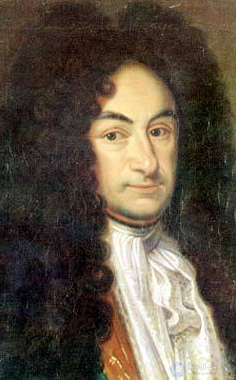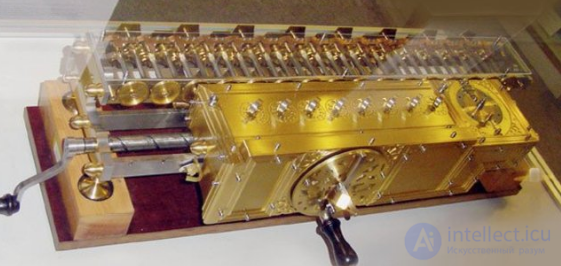Lecture
Gottfried Leibniz
Gottfried Wilhelm Leibniz was born on June 21, 1646 in Leipzig, Germany, in the family of a professor of philosophy and morality at the University of Leipzig. From an early age he already had unlimited access to his father’s library, where he could read a lot. When Gottfried was six years old, his father died, not having managed to pass on his passion for chronology to his young son. By the age of ten, Leibniz studied the books of Cicero, Pliny, Herodotus, Xenophanes and Plato. At a more mature age, he confirmed that the ancient writers had a tremendous influence on his worldview. As a child, he established two rules for himself: accuracy and clarity of thought and the completion of the work begun. These two rules led him to the study of logic - one of the passions of his life.


Being engaged in self-education, Leibniz, at the age of 15, was already ready to enter the University of Leipzig. Learning Latin from the age of eight and Greek from the age of twelve, he realizes that classical training no longer satisfies him, and he turns to logic.
Then Gottfried Leibniz enters the University of Leipzig in the Faculty of Law. While studying law, he still finds time to study the records of such philosophers as Kepler, Galileo, Descartes, and Llull. Noticing that modern philosophy is understandable only to those who are familiar with mathematics, Leibniz spends the entire summer of 1663 at the University of Jena, leaning on a mathematical basis, which he believes should lead him to deeper knowledge.
At age 17, Leibniz earns a bachelor's degree. In 1666, being already fully ready to receive a doctorate in jurisprudence, he decided to leave the university. At the faculty, everyone was perplexed (after all, at the age of 20, Leibniz knew much more in the field of jurisprudence than all his teachers) and considered the main reason for his departure - youth.
And Leibniz, leaving school in Leipzig, leaves for Nuremberg, where, at the University of Altdorf, next year he receives a doctorate for his new (historical) method of teaching law. He not only receives a degree, but also the recognition of society, the university asks him to occupy the position of professor of jurisprudence, from which Leibniz, for unknown reasons, refuses.
Shortly after receiving his degree, Leibniz sets off on a journey, through Frankfurt and Mainz, to Holland, where a vast world opens up before him, a great mind captivated by philosophy and theology, diplomacy and politics, mathematics and alchemy.
Here Leibniz impresses everyone with his new method of teaching law, and after meeting with Baron von Boineburg he is assigned various diplomatic tasks.
In 1672, at the age of 26, Leibniz was invited to Paris - a meeting place for European scientists - to explain his new method. Here his first grandiose ideas ripen: works on natural philosophy and theology, differential and integral calculus, created by him under the fruitful influence of the atmosphere that prevailed around the great Huygens. During this period, Leibniz begins to be interested in mechanical devices. His time with Spinoza also belongs to Paris time, and he makes the first sketches of “theodicy”.
Theodicy is a term proposed by Leibniz himself to refer to a philosophical doctrine that attempts to explain how to combine the existence of evil in the world with the recognition of the “all-goodness” and the “omnipotence” of God. In 1710, Leibniz wrote a treatise under this title.
By the Paris time are his first thoughts about the binary number system. Leibniz made a contribution to symbolic logic, formulated the fundamental properties of logical addition and logical multiplication, negation, and identity. But only two centuries later the English mathematician George Boole came to the conclusion that any logical actions and transformations belong directly to the field of algebra. Largely thanks to the work of Leibniz and Buhl, today's computers perform all logical operations.
In addition to symbolic logic, which plays an important role in modern computing, Leibniz also saw the advantage of the binary number system in bringing the required arithmetic operations to the simplest form. French mathematician Pierre-Simon Laplace will write a century later: “Leibniz saw in binary arithmetic the image of creation, one and zero express all numbers in the number system”.
In 1676, Leibniz entered the service of the Elector of Hanover. In a small town, the residence of the Elector, an inventive mind devotes his leisure to a wide variety of activities. Along with an experimental and theoretical study of the concept of kinetic energy, Leibniz is also engaged (1678) in working on technical projects, including the failed project of pumping water from the Harz mines using windmills. Finally, an arithmetic machine was built (1694), which cost Leibniz 24,000 thalers.
Arithmetic machine Leibniz
One can understand the pride of Leibniz, who wrote then to Thomas Burnet: “I was lucky to build such an arithmetic machine, which is completely different from Pascal’s machine, because it makes it possible to instantly perform multiplication and division over huge numbers.” The arithmetic machine Leibniz was the first machine in the world to carry out the four actions of arithmetic.
He began working on this machine back in the 70s. And the first description of the “arithmetic instrument” was made by him in 1670; two years later, he compiled a new sketchy description, on the basis of which the specimen was apparently made, which the scientist demonstrated in February 1673 at a meeting of the Royal Society of London. Leibniz admitted that the “instrument” was imperfect, and promised to improve it as soon as he returned to Paris. Indeed, in the years 1674-1676 he made significant improvements to the machine, but only came to its final version in 1694. Subsequently, Leibniz returned to his invention several times; the latter was proposed by him in 1710.
Arithmetic machine Leibniz

At first Leibniz tried to only improve Pascal’s car, but he understood that to perform multiplication and division operations, a completely different principle was needed that would allow: to do with one setting of multiplicand; enter the multiplicand into the counter (i.e., receive multiples and their sums) with the same movement of the drive handle. Leibniz brilliantly solved this problem by proposing to use a cylinder, on the parallel forming side surface of which there are 9 steps of various lengths. This cylinder was later called the “speed roller”.
The idea of Leibniz - the idea of a stepped roller - was embodied in the further development of mechanical calculators, up to the twentieth century.
Interestingly, one of the first copies of the “arithmetic tool” Leibniz intended to donate to Peter I, but the car turned out to be faulty, and the scientist’s mechanic could not fix it in a short time. Leibniz was keenly interested in the young Tsar of distant Muscovy, whom he considered an outstanding reformer. Peter met and corresponded with Leibniz, discussed with him the project of the organization of the Academy of Sciences in St. Petersburg and the deployment of the education system in Russia.
While working on the arithmetic machine, Leibniz also continues to work on the binary number system. In a manuscript in Latin, signed on March 15, 1679, Leibniz explains how to perform calculations in the binary number system, in particular multiplication, and later develops in general terms the design of a computer operating in the binary number system. Here is what he writes: “Calculations of this kind could also be performed on a machine. Undoubtedly, it can be done very simply and without special expenses as follows: it is necessary to make holes in the can so that they can be opened and closed. Those openings that correspond to 1 will be open, and the corresponding to 0 will be closed. Small cubes or balls will fall into the gutters through open openings, and nothing will fall out through closed openings. The bank will move and move from column to column, as required by multiplication. The gutters will represent the columns, and no ball can get from one gutter to any other until the machine starts working ... ”Later on in numerous letters and in the treatise“ Explication de l'Arithmetique Binairy ”(1703) Leibnitz again and again returned to binary arithmetic.
Subsequently, Leibniz’s idea of using the binary number system in computers was forgotten for 250 years, and only in 1931 digital gears with eight positions (23 = 8) would patent R. Walt in France. In 1936, he will show the benefits of binary computing devices. Following Walt, L. Cuffignal in France and E. Phillips in England will do the same.
How did Leibniz manage to do so much in various fields of science? He simply had the ability to work anywhere, at any time and under any conditions. He read a lot, wrote down and constantly thought. He did not have a fixed time for eating, but when a convenient opportunity arose during his studies, he was distracted to eat. He was idle a little, often spent the night in his chair, and sometimes for several days. This allowed him to do a great job, but it also led to illness.
Contemporaries Leibniz was struck by his fantastic erudition, almost supernatural memory and amazing performance.
But it was not these qualities that determined Leibniz’s genius. The main thing was his ability to see in any problem, grasp what was its essence, its foundation. He, like no one else, was able to generalize. This insatiable need for generalization forced him all his life to seek a universal method of scientific knowledge.
After creating an arithmetic machine, in 1675, Leibniz returned to the study of mathematics and devoted all his free time to creating the foundations of differential and integral calculus.
Leibniz began to serve in the German house of Brunswick as a historian, librarian, and chief adviser. In the years 1687-1690 historical research led him to Austria and Italy. During his stay in Italy, Leibniz visited Rome and was invited by the Pope to the place of librarian in the Vatican. Since this position required the adoption of the Catholic faith, Leibniz rejected the proposal of the Pope. Instead, he attempted to reunite the Protestant and Catholic churches, which split at the beginning of the century. But after some effort, Leibniz was forced to forget about this project.
In later years, Leibniz turned to philosophy, and his final philosophical composition was “Monadology”. The last significant event in his life happened in 1700, in Berlin, where he organized the Berlin Academy of Sciences and became its first president.
The last years of Leibniz were overshadowed by illness and misunderstanding of those around him, he suffered from gout. November 14, 1716, at the age of 70, he passed away. His death went unnoticed in London and Berlin, and the only person who took him on his last journey was his secretary. Where he is buried is unknown.
However, subsequent generations appreciated the services of Leibniz. And today, of course, Leibniz is presented to us as one of the greatest minds of its time.
Comments
To leave a comment
Persons
Terms: Persons